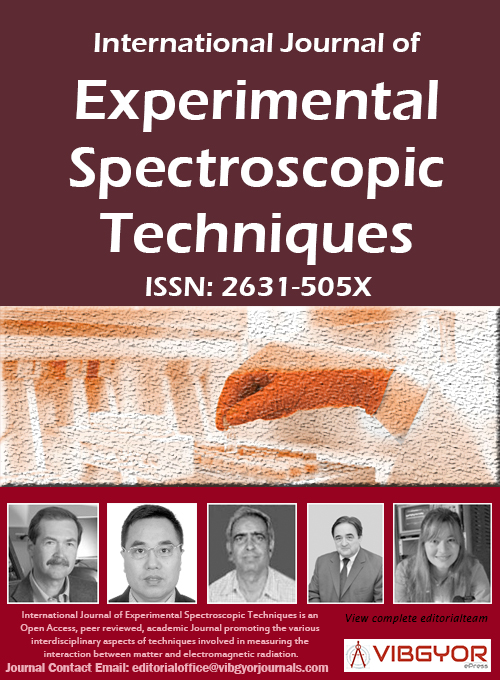
International Journal of Experimental Spectroscopic Techniques
(ISSN: 2631-505X)
Volume 7, Issue 1
Research Article
DOI: 10.35840/2631-505X/8531
Assessment of Ambient Radioactive Contamination
CA Kalfas1*
References
- Tsabaris C, Eleftheriou G, Kapsimalis V, Anagnostou V, Vlastou R, et al. (2007) Radioactivity levels of recent sediments in the Butrint Lagoon and the adjacent coast of Albania. Appl Radiat Isot 65: 445-453.
- Eleftheriou G, Tsabaris C, Androulakaki EG, Patiris DL, Kokkoris M, et al. (2007) Radioactivity measurements in the aquatic environment using in-situ and laboratory gamma-ray spectrometry. Applied Radiation and Isotopes 65: 445-453.
- Tsabaris C, Androulakaki EG, Alexakis S, Patiris DL (2018) An in-situ gamma-ray spectrometer for the deep ocean. Applied Radiation and Isotopes 142: 120-127.
- Kalfas CA, Axiotis M, Tsabaris C (2016) SPECTRW: A software package for nuclear and atomic spectroscopy. Nucl Instrum Methods A 830: 265-274.
Author Details
CA Kalfas1*
1National Centre for Scientific Research Demokritos, Institute of Nuclear & Particle Physics, Agia Paraskevi, Greece
Corresponding author
CA Kalfas, National Centre for Scientific Research Demokritos, Institute of Nuclear & Particle Physics, 15310 Agia Paraskevi, Dodekanisou 23A, 15235 Vrilissia, Athens, Greece.
Accepted: July 08, 2022 | Published Online: July 11, 2022
Citation: Kalfas CA (2022) Assessment of Ambient Radioactive Contamination. Int J Exp Spectroscopic Tech 7:031
Copyright: © 2022 Kalfas CA. This is an open-access article distributed under the terms of the Creative Commons Attribution License, which permits unrestricted use, distribution, and reproduction in any medium, provided the original author and source are credited.
Abstract
An alternative method for assessing the radioactive contamination in a storage room is presented. The data used are from a real case. The same method can also be used in situ to determine the natural radioactivity level in various fields such as a sandy beach.
Introduction
Assessing the radioactive contains in a sample does not present serious difficulties. All is required is a detection system, usually a HPGe detector with the associated electronics. The important points are a good efficiency and energy calibration of the system. Normally this is done in the laboratory with the necessary shielding and care must be taken to use calibration sources with a geometry and density similar to the samples [1,2]. However, the same task for in-situ measurements, either in aquatic environment or in land, is far more complex. For aquatic environments various detection systems (such KATERINA [3]) have been designed and the appropriate software developed. They have been used and tested in actual field condition (e.g. after the Fukushima accident). The assessment of ambient radioactive contamination in land, either natural or man-made, presents additional difficulties. The air surrounding the detector naturally cannot play the same role as the water in an aquatic environment because it is not the air carrying the radioactive traces. Various techniques using modeling software exist. In the present work we describe an alternative method that relies mostly on experimental evaluation.
Materials and Methods
In addition to the requirements for sample analysis, as described in the introduction, the extra requirements in the method described below are a) a spectra analysis software that can pin-point the gamma-ray photo peaks with the smallest possible uncertainty and b) a reliable gamma-ray simulation software. In our case we used for both, data analysis and simulation, the SPECTRW [4] software which has been extensively tested in the last 6 years. Some time ago, our spectroscopy group was assigned with the task to examine and determine the radioactive contamination in a storage house serving as the national in and out gate for radioactive materials. The storage house with a metal roof (a hangar) was to be demolished and what was in stake was the health of the workers who would be doing the demolition. The steps that were followed (and constitute the suggested methodology) are:
a) A HPGe detector with 30% nominal relative efficiency and 2 keV FWHM resolution was placed in 4 different spots in the storage room and a set of 4-hour spectra were recorded. Examination of the 4 spectra showed only minor differences, so the average was produced. The storage house is labeled Hangar1.
b) A similar set of spectra was taken from a nearby similar hangar. This set was taken for comparison reasons and would be called Hangar2.
c) Back in the laboratory the 2 sets of spectra were analyzed.
d) The analysis of the average spectrum of Hangar1 gave the following results (Table 1).
Assuming a temporal efficiency which was determined using radioactive sources at a distance of 50 cm and based on these results, a simulated spectrum was constructed. Then the simulated spectrum was normalized using a multiplication factor so that the number of counts under each photo peak matched those of the actual spectrum. Then the simulated spectrum was subtracted from the real one (Figure 1).
For comparison, the three spectra are superimposed in Figure 2.
Details of the analysis of the low energy part of the spectrum (200 keV - 400 keV) are shown in Figure 3 and Figure 4.
Integrating the simulated and the net spectra showed that the discrete part due to natural radioactivity and to contamination was only ~17% compared to the cosmic background appearing as a continuous spectrum. Furthermore, as shown in Table 2, most of the discrete part is due to natural radioactivity.
Table 2 shows the results of the analysis, appropriately grouped, for Hangar1 and Hangar2. The numbers in parenthesis are the uncertainties (one standard deviation):
Conclusions
Comparing a widely spread radioactive contamination with the cosmic gamma-ray background appears to be a working method, not depending on any model assumptions. In the present test case, the contamination was expected to be negligible and the results justified the expectation. The project was used as a severe test of the method since the statistics were anticipated to be very low. In addition, the selected case had the advantage of an adjacent comparison site.

